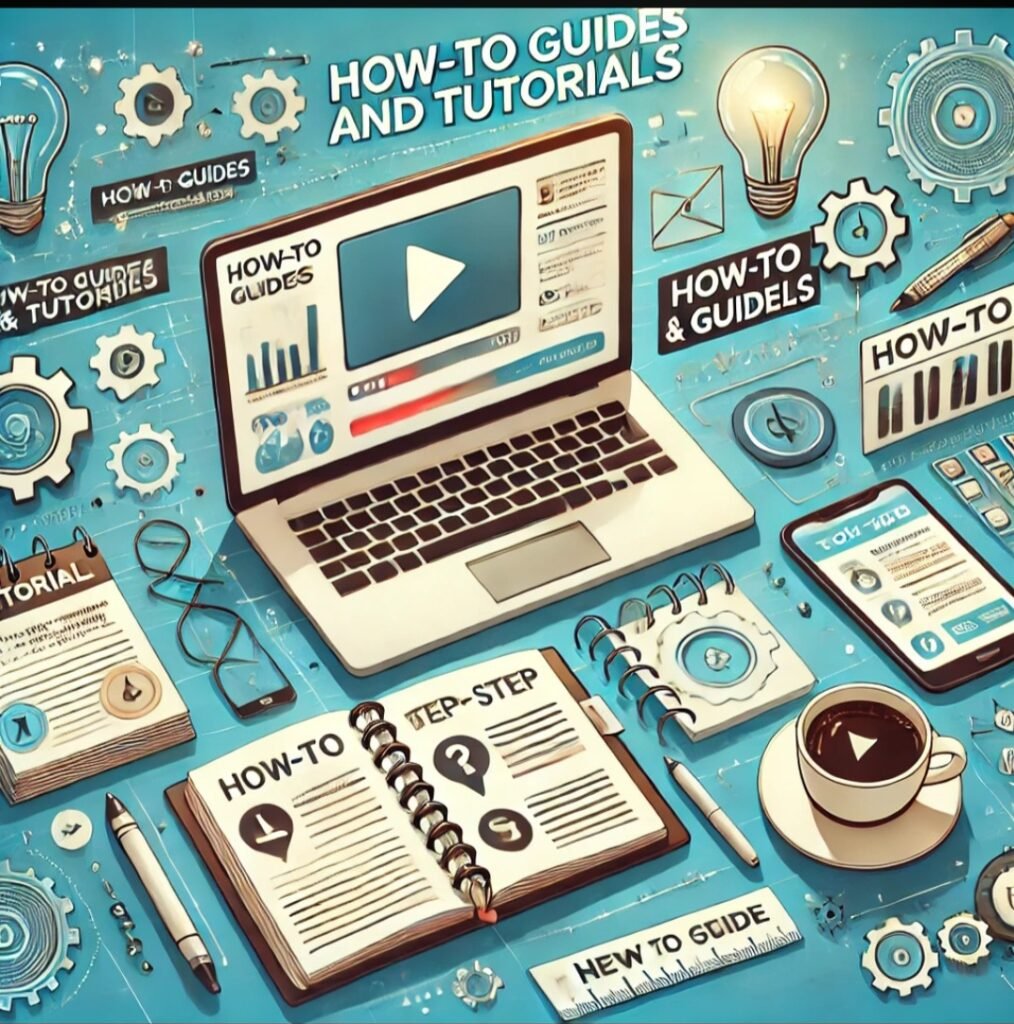How-To Guides and Tutorials
Discover the ultimate guide to creating effective how-to guides and tutorials. Learn step-by-step strategies to master new skills, optimize for SEO, and boost your website traffic today!”
introduction
In today’s fast-paced digital world, people are increasingly turning to the internet for solutions to their problems. Whether it’s learning how to fix a leaking pipe, setting up a blog, or mastering a new software program, how-to guides and tutorials have become the go-to resources for solving real-life problems. If you’ve ever found yourself Googling “How to do something,” you know how valuable these guides can be.
But there’s more to creating these educational resources than simply offering step-by-step instructions. How-to guides and tutorials are not just helpful for users—they are also powerful tools for building authority, driving traffic, and enhancing SEO for your website. In this guide, we’ll explore the value of how-to guides, how to write them effectively, and how to optimize them to rank high in Google search results.

The Importance of How-To Guides and Tutorials
How-to guides and tutorials are essential for anyone seeking to learn new skills or complete tasks. These resources provide clear, actionable instructions, helping readers navigate complex processes and solve problems with ease. But beyond their practical benefits, how-to guides are incredibly valuable from an SEO perspective.
Google rewards high-quality, informative content, and how-to guides fit that bill perfectly. With the right optimization, they can rank highly in search engine results, driving organic traffic to your site. They also foster engagement—people tend to spend more time on pages that offer valuable, well-organized content. This can improve your site’s bounce rate, leading to better rankings.How-To Guides and Tutorials
Another major benefit is trust. By providing well-researched, helpful tutorials, you position your website as a go-to resource for learning. Readers are more likely to return to your site for future solutions, and they’ll share your content with others, further increasing your reach.How-To Guides and Tutorials

Crafting a Great How-To Guide or Tutorial
Creating a successful how-to guide involves more than just outlining the steps to complete a task. It’s about providing clarity, value, and a positive user experience. Here’s how you can structure your how-to guide to make it as effective as possible:How-To Guides and Tutorials
Start with a Clear, Concise Title The title of your guide should clearly indicate what the tutorial covers. For example, instead of a vague title like “Blogging Tips,” opt for something more specific like “How to Create a WordPress Blog in 10 Easy Steps.” A good title is both descriptive and SEO-friendly, incorporating keywords that users are likely to search for.How-To Guides and Tutorials
Introduce the Topic Your introduction should explain what the guide will cover and how it will benefit the reader. Let your audience know what problem your tutorial will solve, and give them an overview of the steps involved. This sets expectations and makes the reader feel more confident in proceeding with your guide.How-To Guides and Tutorials
Break Down the Process with Step-by-Step Instructions The heart of any good how-to guide is the step-by-step breakdown of the task. Each step should be easy to follow and free of unnecessary jargon. Remember, your goal is to make the process as simple and straightforward as possible. Numbered or bulleted lists are perfect for this kind of content, as they allow readers to quickly scan and follow along.How-To Guides and Tutorials
Include Visuals to Clarify Instructions People are visual learners, and adding images, screenshots, or videos can significantly improve the user experience. Visuals help break up the text and make complex steps easier to understand. For example, if you’re teaching someone how to install a WordPress plugin, include a screenshot showing the plugin interface. Don’t forget to optimize your images for SEO by including descriptive alt text and using appropriate file names.How-To Guides and Tutorials

Provide Additional Tips and Resources After walking the reader through the primary steps, offer bonus tips or additional resources to enhance their experience. This could include recommending tools, linking to other relevant tutorials on your site, or sharing expert advice. Not only does this make your content more comprehensive, but it also establishes you as an authority in your niche.How-To Guides and Tutorials
End with a Call to Action Once the reader has completed the steps in your guide, encourage them to take the next step. Whether it’s signing up for a newsletter, downloading a resource, or trying a related tutorial, a strong call to action (CTA) helps maintain the momentum and encourages further engagement with your content.How-To Guides and Tutorials
Writing High-Quality How-To Guides
The key to creating a successful how-to guide is writing high-quality content that addresses the reader’s needs. Here are some tips for writing guides that are informative, engaging, and helpful:
Know Your Audience Before you start writing, think about who will be reading your guide. Are they beginners, or are they more experienced? Tailor your language, examples, and explanations to match your audience’s level of expertise. If you’re writing a beginner’s guide, keep things simple and avoid industry jargon.
Research Thoroughly Even if you’re an expert in the subject, it’s important to do your research. Look at what other tutorials are available on the topic, identify any gaps in the existing content, and find ways to provide additional value. Researching your topic also ensures that you’re offering the most up-to-date and accurate information.
Organize Your Content A good how-to guide needs to be well-organized. Use headings and subheadings to break your content into digestible sections. This not only makes it easier for readers to follow, but it also helps with SEO by allowing search engines to understand the structure of your content.
Use Real-Life Examples Whenever possible, use examples or case studies to help explain your points. This makes your guide more relatable and engaging, and it helps the reader understand how to apply the information in real-life situations.
Edit and Proofread Before publishing your how-to guide, take the time to edit and proofread. Even small errors can detract from the credibility of your content. A well-polished guide not only looks more professional, but it also ensures a smoother experience for the reader.
Optimizing How-To Guides for SEO
Now that you know how to write an effective how-to guide, it’s time to ensure it’s optimized for search engines. SEO is essential if you want your guide to rank highly on Google. Here are some tips for optimizing your how-to content:
Use the Right Keywords Start by identifying the keywords your audience is likely to search for. Tools like Google Keyword Planner or SEMrush can help you find relevant keywords for your how-to topic. Incorporate these keywords naturally throughout your content, especially in the title, headings, and introduction.
Optimize for Featured Snippets Google often features how-to guides directly in search results in the form of featured snippets. To increase your chances of being featured, structure your guide so that it includes concise, easy-to-read steps or a bullet-point summary. Aim for clarity and brevity to make it more likely that Google will select your content for a snippet.
Optimize Visuals for SEO Images, infographics, and videos can significantly enhance your how-to guide, but they also need to be optimized for SEO. Use descriptive alt text for every image and ensure they load quickly by compressing large files. This will help your content rank higher in image search results and improve page load times.
Internal and External Linking Linking to other relevant content on your site can boost SEO by creating a network of related articles. External links to authoritative sources can also improve your guide’s credibility. Just make sure that any external links you include are high-quality and relevant.
Improve Page Speed Google rewards websites that load quickly. Make sure your page is optimized for speed by compressing images, minimizing code, and using a reliable hosting service. Tools like Google PageSpeed Insights can help you identify areas for improvement.
Promoting and Updating Your How-To Guides
Once your how-to guide is live, the next step is to promote it. Share your content on social media, email newsletters, and other channels where your audience hangs out. Encourage readers to comment, share, and subscribe for more tutorials.
It’s also important to regularly update your guides to keep them relevant. This could mean adding new steps, updating information, or revising examples. Google rewards fresh, up-to-date content, so make it a habit to revisit your tutorials and make improvements as needed.
Common Mistakes to Avoid
When writing how-to guides, it’s easy to fall into a few common traps. Here are some mistakes to avoid:
Being Too Vague Don’t leave your readers guessing. Be specific and detailed in your instructions to ensure they can follow along easily.
Ignoring Mobile Optimization Many users will access your how-to guides on mobile devices. Make sure your content is mobile-friendly by using responsive design.
Overloading with Information While it’s important to be thorough, avoid overwhelming your readers with too much information at once. Keep your steps clear and concise.
Conclusion
How-to guides and tutorials are incredibly valuable for both your audience and your website. By creating high-quality, SEO-optimized tutorials, you not only help your readers solve problems, but you also drive traffic, increase engagement, and build authority in your niche. With the right strategy and a focus on user experience, your how-to guides can become powerful tools for growing your online presence.
So, what are you waiting for? Start writing your next how-to guide today and watch your website traffic soar!

